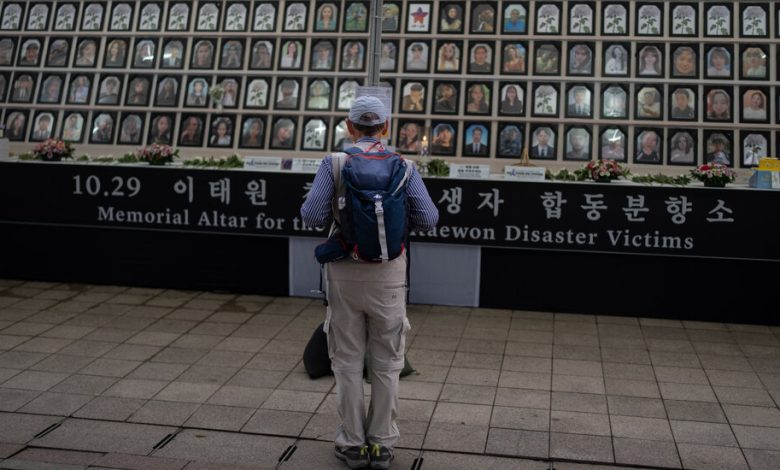Little Punishment or Change After South Korea’s Halloween Calamity

From the beginning, with the grief still raw and anguished questions unanswered, the South Korean government distanced itself from the disaster that unfolded last year on a Halloween weekend in Seoul.
Nearly 160 revelers were crushed to death in a narrow alleyway in the Itaewon neighborhood, after huge throngs had amassed with no police officers to control them, despite official warnings that the gathering would be unusually large after the end of pandemic restrictions.
Over the days that followed, in a response that drew scorn and ridicule among many South Koreans, the government insisted that it did not have responsibility for public safety on the streets that night because the Halloween festivities had not been formally organized. Instead, the government blamed local police and other officials for failing to deal with the emergency.
Now, with another Halloween approaching, the families say far too little has been done to make sure such a catastrophe does not happen again.
While bar and nightclub owners in Itaewon have decided not to promote Halloween-themed events this year, they are hopeful that a sizable crowd will turn out and bolster confidence in the neighborhood, whose entertainment area became a ghost town in the months after the disaster.
City officials say they are taking extra security precautions. Seoul has begun adding hundreds of high-resolution surveillance cameras and plans to use artificial-intelligence technology to watch crowds in Itaewon and other entertainment zones. Officials say they plan to send up to 300 officials and police officers to Itaewon and keep a battalion of police officers on standby to intervene if streets become congested. They will open an ad hoc control center there to monitor the crowd. And they have changed street tiles to make Itaewon’s sloping alleyways less slippery.
But the families of the disaster victims say an underlying cause of the calamity remains unaddressed: a bureaucracy that fails to prioritize public safety and refuses to come clean on its shortcomings, shielding politically appointed bosses in a deeply hierarchical culture.
“The whole government was united in trying to push this case under the surface,” said Lee Jeong-min, who lost a daughter in Itaewon and leads a campaign by victims’ families for justice. “One thing we learned in the past year is that no safety system matters unless you have a government with a sense of responsibility.”
In the aftermath of the deaths, the government of President Yoon Suk Yeol ordered officials to stop calling the crowd crush a “disaster” and its casualties “victims,” referring to them as an “accident” and “the dead.” And Mr. Yoon ignored demands from victims’ families to set an example by firing top safety officials, and dismissed requests for a meeting and an apology.
A bill that would categorically stipulate that it is the government’s duty to prepare safety measures when large groups of people are expected to gather without organizers has yet to clear the National Assembly.
Opposition lawmakers and relatives of the victims are also pushing for a special law to open an independent investigation into the disaster, after Mr. Yoon’s government allowed the National Police Agency to investigate itself in the Itaewon case.
The families’ worst fears were confirmed when the police agency cleared its own top bosses and those at the Ministry of the Interior and Safety of any wrongdoing, while prosecutors indicted 12 local police and other officials on charges such as negligence of official duty. No verdicts have come as the trials have dragged on. Investigators asked prosecutors to indict the Seoul police chief on similar charges, but the prosecutors have yet to act.
The families say that high-level officials should be punished to make clear that they bear responsibility in large-scale disasters like the Itaewon crush, and that structural changes to prevent such calamities will be possible only if the full truth of what happened is exposed.
On the night of Oct. 29, person after panicked person called police and fire department hotlines for hours, reporting a dangerous crowd surge developing in the cramped alleyway in Itaewon. Eventually, hundreds of people began to fall on top of each other as waves of revelers pushed up and down the sloping strip of pavement, jostling to go in opposite directions.
As the partygoers were suffocating and dying, hundreds of police officers deployed for other duties were less than a mile away. The fire department’s nearest first-response center was 660 feet away. The nearest police station was even closer: 330 feet away. But the desperate calls from worried passers-by went unheeded for hours.
After the disaster, Mr. Yoon said he felt “an indescribable sadness” at the deaths of the 159 people, including 26 foreigners, most in their 20s and 30s. His government vowed to make the country safer.
But its unpreparedness in handling emergencies was exposed again this year when floodwaters filled an underpass in July, killing 14 drivers and passengers, and when the World Scout Jamboree descended into chaos in August. In both cases, officials failed to heed warnings of danger.
In the Itaewon catastrophe, the families asked whether the police had been too preoccupied with guarding the vicinity of Mr. Yoon’s office, which he had moved nearby. On the day of the crowd crush, thousands of officers were deployed to monitor peaceful anti-Yoon demonstrators, a regular occurrence in Seoul. Dozens of plainclothes police officers were in Itaewon — to carry out Mr. Yoon’s war on drugs, not to control the crowd.
The authorities’ claim that they lacked a mandate to regulate the crowds because the festivities had no organizers was “an excuse,” said Ha Kag-Cheon, an expert in disaster prevention at U1 University, a private school in central South Korea. “It’s a basic duty of the authorities to make preparations and ensure safety when a large crowd is expected.”
After the disaster, bars and nightclubs closed as people shunned Itaewon, a neighborhood in the central Yongsan district where foreigners and locals have long gathered for the party atmosphere. Some owners moved their businesses elsewhere in Seoul. Those who remained organized flea markets and indie-band nights to help bring customers back. The government provided cheap loans and 20 percent discount coupons to visitors.
Today, Itaewon clubs have regained 60 to 70 percent of their business, said Yoo Tae-Hyuk, who runs a club near the disaster alleyway and leads an association of Itaewon store owners.
During a recent weekend evening, young nightclub workers in black T-shirts were out enticing passers-by. People sipped beer around veranda tables, enjoying a cool October evening. From a bar floated Pharrell Williams’s song “Happy.”
“We have to change people’s perception of Itaewon as a scary place, a place they are afraid to visit,” said Hwang Soon-Jae, who runs jazz and rock ’n’ roll bars.
The alleyway still stands as a monument to the tragedy. On a rust-colored metal wall at its entrance, hundreds of handwritten messages from residents and visitors from around the world mourn the dead. “I hope we can take steps to prevent this kind of tragedy from ever happening again,” one message said.
That wall, which investigators said a neighborhood hotel added to its side years ago without permission, made the alleyway even more cramped. The hotel’s managers are on trial on charges of violating building codes.
South Korea has been plagued by a series of human-caused disasters, including a department store collapse, a ferry sinking and catastrophic fires. The country has laws and guidelines on disaster prevention but not enough official commitment, experts said. Career bureaucrats, they added, are more preoccupied with catering to the “mood” — or political needs — of their bosses than with ensuring public safety.
“Halloween in Itaewon had drawn large crowds in the previous years, too,” said Yoon Yong-Kyun, an expert in disaster prevention at Semyung University. “If only one of the top bosses — the chiefs of Yongsan, the police and Seoul City or the president — had asked officials whether they had safety plans in place, the disaster would not have happened.”





